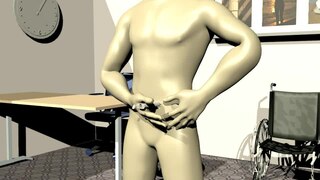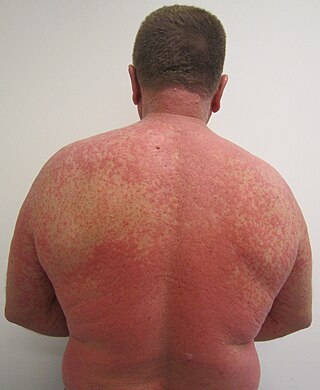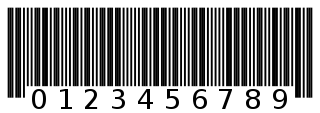
A pharmacist, also known as a chemist in Commonwealth English, is a healthcare professional who is knowledgeable about preparation, mechanism of action, clinical usage and legislation of medications in order to dispense them safely to the public and to provide consultancy services. A pharmacist also often serves as a primary care provider in the community and offers services, such as health screenings and immunizations.

Subcutaneous administration is the insertion of medications beneath the skin either by injection or infusion.
A medical error is a preventable adverse effect of care ("iatrogenesis"), whether or not it is evident or harmful to the patient. This might include an inaccurate or incomplete diagnosis or treatment of a disease, injury, syndrome, behavior, infection, or other ailment.

An adverse drug reaction (ADR) is a harmful, unintended result caused by taking medication. ADRs may occur following a single dose or prolonged administration of a drug or may result from the combination of two or more drugs. The meaning of this term differs from the term "side effect" because side effects can be beneficial as well as detrimental. The study of ADRs is the concern of the field known as pharmacovigilance. An adverse event (AE) refers to any unexpected and inappropriate occurrence at the time a drug is used, whether or not the event is associated with the administration of the drug. An ADR is a special type of AE in which a causative relationship can be shown. ADRs are only one type of medication-related harm. Another type of medication-related harm type includes not taking prescribed medications, known as non-adherence. Non-adherence to medications can lead to death and other negative outcomes. Adverse drug reactions require the use of a medication.
Cardiotoxicity is the occurrence of heart dysfunction as electric or muscle damage, resulting in heart toxicity. This can cause heart failure, arrhythmia, myocarditis, and cardiomyopathy in patients. Some effects are reversible, while in others, permanent damage requiring further treatment may arise. The heart becomes weaker and is not as efficient in pumping blood. Cardiotoxicity may be caused by chemotherapy treatment and/or radiotherapy; complications from anorexia nervosa; adverse effects of heavy metals intake; the long-term abuse of or ingestion at high doses of certain strong stimulants such as cocaine; or an incorrectly administered drug such as bupivacaine.

Levobupivacaine (rINN) is a local anaesthetic drug indicated for minor and major surgical anaesthesia and pain management. It is a long-acting amide-type local anaesthetic that blocks nerve impulses by inhibiting sodium ion influx into the nerve cells. Levobupivacaine is the S-enantiomer of racemic bupivacaine and therefore similar in pharmacological effects. The drug typically starts taking effect within 15 minutes and can last up to 16 hours depending on factors such as site of administration and dosage.
Patient safety is a discipline that emphasizes safety in health care through the prevention, reduction, reporting and analysis of error and other types of unnecessary harm that often lead to adverse patient events. The magnitude of avoidable adverse events, often known as patient safety incidents, experienced by patients was not well known until the 1990s, when multiple countries reported significant numbers of patients harmed and killed by medical errors. Recognizing that healthcare errors impact 1 in every 10 patients around the world, the World Health Organization (WHO) calls patient safety an endemic concern. Indeed, patient safety has emerged as a distinct healthcare discipline supported by an immature yet developing scientific framework. There is a significant transdisciplinary body of theoretical and research literature that informs the science of patient safety with mobile health apps being a growing area of research.
A patient safety organization (PSO) is a group, institution, or association that improves medical care by reducing medical errors. Common functions of patient safety organizations are data collection, analysis, reporting, education, funding, and advocacy. A PSO differs from a Federally designed Patient Safety Organization (PSO), which provides health care providers in the U.S. privilege and confidentiality protections for efforts to improve patient safety and the quality of patient care delivery

In the field of pharmacy, compounding is preparation of custom medications to fit unique needs of patients that cannot be met with mass-produced products. This may be done, for example, to provide medication in a form easier for a given patient to ingest, or to avoid a non-active ingredient a patient is allergic to, or to provide an exact dose that isn't otherwise available. This kind of patient-specific compounding, according to a prescriber's specifications, is referred to as "traditional" compounding. The nature of patient need for such customization can range from absolute necessity to individual optimality to even preference.
Overmedication describes the excessive use of over-the-counter or precription medicines for a person. Overmedication can have harmful effects, such as non-adherence or interactions with multiple prescription drugs.

Clinical pharmacy is the branch of pharmacy in which clinical pharmacists provide direct patient care that optimizes the use of medication and promotes health, wellness, and disease prevention. Clinical pharmacists care for patients in all health care settings but the clinical pharmacy movement initially began inside hospitals and clinics. Clinical pharmacists often work in collaboration with physicians, physician assistants, nurse practitioners, and other healthcare professionals. Clinical pharmacists can enter into a formal collaborative practice agreement with another healthcare provider, generally one or more physicians, that allows pharmacists to prescribe medications and order laboratory tests.

Chemotherapy-induced acral erythema, also known as palmar-plantar erythrodysesthesia or hand-foot syndrome is reddening, swelling, numbness and desquamation on palms of the hands and soles of the feet that can occur after chemotherapy in patients with cancer. Hand-foot syndrome is also rarely seen in sickle-cell disease. These skin changes usually are well demarcated. Acral erythema typically disappears within a few weeks after discontinuation of the offending drug.

Tall man lettering is the practice of writing part of a drug's name in upper case letters to help distinguish sound-alike, look-alike drugs from one another in order to avoid medication errors. For example, in tall man lettering, "prednisone" and "prednisolone" should be written "predniSONE" and "predniSOLONE", respectively. The Office of Generic Drugs of the US Food and Drug Administration (FDA) encourages manufacturers to use tall man lettering labels to visually differentiate their drugs' names, and a number of hospitals, clinics, and health care systems use tall man lettering in their computerized order entry, automated dispensing machines, medication admission records, prescription labels, and drug product labels.

Bar code medication administration (BCMA) is a barcode system designed by Glenna Sue Kinnick to prevent medication errors in healthcare settings and to improve the quality and safety of medication administration. The overall goals of BCMA are to improve accuracy, prevent errors, and generate online records of medication administration.
Drug therapy problems (DTPs) represent the categorization and definition of clinical problems related to the use of medications or "drugs" in the field of pharmaceutical care. In the course of clinical practice, DTPs are often identified, prevented, and/or resolved by pharmacists in the course of medication therapy management, as experts on the safety and efficacy of medications, but other healthcare professionals may also manage DTPs.

Magnesium taurate, also known as magnesium ditaurate or magnesium taurinate, is the magnesium salt of taurine, and a mineral supplement.
Medicines reconciliation or medication reconciliation is the process of ensuring that a hospital patient's medication list is as up-to-date as possible. It is usually undertaken by a pharmacist and may include consulting several sources such as the patient, their relatives or caregivers, or their primary care physician.
Travel health nursing is a nursing specialty which promotes the health and safety of national and international travelers. Similar to travel medicine, it is an interdisciplinary practice which draws from the knowledge bases of vaccines, epidemiology, tropical medicine, public health, and health education. Travel nursing has experienced an increase in global demand due to the evolution of travel medicine. Travel health nursing was recognized during the 1980s as an emerging occupation to meet the needs of the traveling public, and additional education and training was established. Travel health nurses typically work in "private practice, hospital outpatient units, universities, the government, and the military", and have more opportunities and leadership roles as travel has become more common. However, they also experience organizational and support-related conflicts with general practitioners and patients in healthcare settings.
John W. Senders was an American professor of industrial engineering and psychology who did research on safety and human error. He founded Canada's Institute for Safe Medication Practices (ISMP), introduced the visual occlusion paradigm, and organized the first conference on human error, which came to be known as Clambake I.









